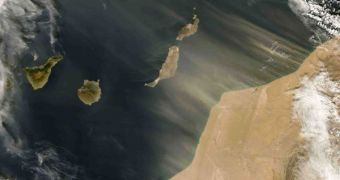A team of investigators from the University of Alabama in Huntsville announced that it will be engaging in a three-year research effort, which will focused on tracking down more than 770 million tons of sand and dust as the stuff is blown off the Sahara Desert.
Scientists know that the dust is spread throughout the atmosphere, and that some of it can even make it to the other side of the world, but they say that no clear image of how it does so is available right now.
Additionally, very little studies sought until now to analyze in-depth the tremendous impact that sand and dust “migration” patterns have on our planet's climate and temperature levels.
As powerful winds carry sand out of the vast Sahara Desert, the stuff can get carried away for various distances. Some of it may fall back on North Africa, whereas important amounts get transported to the Mediterranean Sea, and North and South America.
As the team will keep an eye on the dust, experts say, satellite data will be used to keep tabs on how the sand spreads around the world from this focal point.
“The people who build climate models make some assumptions about dust and its impact on the climate,” explains UAH professor of atmospheric science Sundar Christopher.
“We want to learn more about the characteristics of this dust, its concentrations in the atmosphere and its impact on the global energy budget so we can replace those assumptions with real data,” he adds.
“One thing we want to do is calculate how reflective dust is, because not all dust is created equal. We're trying to calculate reflectivity so we can say with precision how much sunlight is being reflected,” the expert goes on to say.
Such data could in turn be used to inform climate models seeking to determine how much of the sunlight reaching Earth is being reflected back into space.
This is extremely important for climate scientists studying global warming. In this field, knowing the factors that contribute to increases in temperatures can be of the utmost importance.
It is also known from past studies that dust cools the atmosphere. The more particles are in the air, the more sunlight is reflected back into space, and does not get converted into heat.
From this point of view, analyzing the Sahara makes a lot of sense, given that dust being blown off the desert accounts for half of all sand in the Earth's atmosphere at any given point.
The UAH team is sponsored in its endeavors by a $500,000 grant, secured under the NASA Cloud-Aerosol Lidar and Infrared Pathfinder Satellite Observation (CALIPSO) program, OurAmazingPlanet reports.

 14 DAY TRIAL //
14 DAY TRIAL //